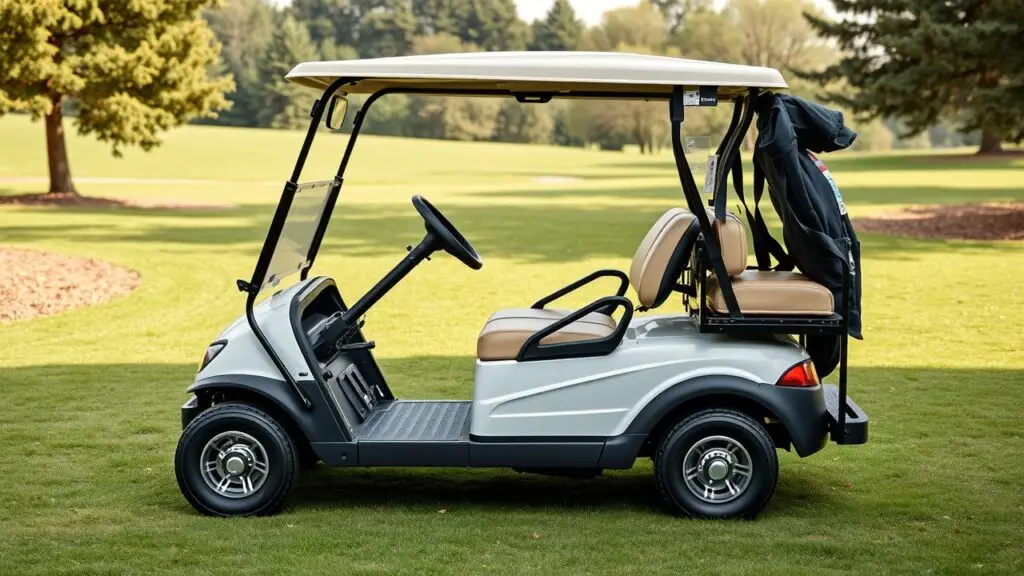Discover the types of golf carts. Choosing the right golf cart depends on your needs. This guide explores various types, including gas, electric, and utility models, comparing features, performance, and top brands to help you find the perfect fit.
What is a Golf Cart?

A golf cart is a small vehicle used to carry golfers and their gear around the golf course. They can run on electricity or gas, which gives you options. While they are mainly seen on golf courses, personal golf carts are also popular for getting around neighborhoods. Commercial models are useful for tasks like maintenance and security.
Most golf carts fit two to four people, but bigger ones can hold more. Many have handy features like storage spaces for clubs, coolers, and sometimes GPS systems.
Why Understanding Different Types Matters?
Picking the right golf cart is super important! It can really change how much fun you have. For folks playing at flat courses, an electric cart might be the best choice because it’s quiet and costs less to run. But if you’re working in hilly areas, a gas-powered cart could be better since it has more power.
Money is also a big deal; knowing what type fits your needs helps you choose one that doesn’t break the bank while still having what you want. Plus, if you know what each type offers, you can decide on cool add-ons or upgrades that make your cart even better.
Overview of Key Categories
There are several types of golf carts available today:
- Gas-Powered Carts: These are fast and good for rough ground.
- Electric Carts: They run quietly and are cheaper to use; perfect for shorter trips.
- Low-Speed Vehicles (LSVs): These are legal on streets and great for neighborhoods.
- Utility Carts: Made for work tasks like moving tools or supplies.
- Luxury Models: Fancy options with high-end materials and cool tech.
Each type meets different needs, so whether you’re looking for something fun or practical, there’s a perfect cart out there for you!
Main Types of Golf Carts Explained
Gas-Powered Golf Carts
Gas-powered golf carts are popular because they perform well and can do many things. These carts use gasoline engines, which can be single-cylinder or two-cylinder. The engine type affects how much power the cart has and how efficient it is.
How They Work?
Gasoline golf carts run on fuel that powers an internal combustion engine. Single-cylinder engines are found in smaller models, while two-cylinder engines give more power. This makes them great for steep hills or long distances.
Advantages
Gas-powered golf carts have some big benefits:
- They offer high power output, making them great for hilly areas.
- They can go a long way on a single tank of gas, perfect for big properties or events.
Disadvantages
On the flip side, these carts can be tricky. Here are some downsides:
- They often need more maintenance because of their complex engines.
- They create emissions and noise, which may not be nice in quiet neighborhoods.
Electric Golf Carts
Electric golf carts are becoming more popular because they are eco-friendly and cheaper to run. These carts use batteries instead of gasoline.
How They Work?
Electric models use either lead-acid or lithium-ion batteries for power. Lead-acid batteries are heavier but traditional; lithium-ion batteries are lighter and charge faster but cost more upfront.
Advantages
Electric golf carts have several perks:
- They run quietly, making them ideal for peaceful places.
- They cost less to maintain since they have fewer moving parts.
- Their eco-friendly design attracts people who care about the environment.
Disadvantages
However, electric golf carts have some limits:
- Their range is usually shorter compared to gas models; after a full charge, they might need recharging after several hours.
- Charging stations may not always be nearby.
Low-Speed Vehicles (LSVs) – Street-Legal Options
Low-speed vehicles (LSVs), also known as street-legal golf carts, follow specific safety standards from regulations like FMVSS (Federal Motor Vehicle Safety Standards).
Definition & Features Required for Street Legality
To be called LSVs, these vehicles must follow strict rules like:
- Speed limits under 25 mph
- Features such as headlights, turn signals, brake lights, and seat belts
Use Cases Beyond the Course
These vehicles aren’t just for golfing; they’re used in neighborhoods or resorts where driving slowly is needed without using regular cars.
Pros & Cons Compared To Standard Electric/Gas Models
While LSVs are great for community travel at lower speeds than regular cars, they might not perform as well as electric or gas models on rough terrains outside city areas.
Utility Golf Carts – Heavy-Duty Applications
Utility golf carts are built for heavy-duty work. They’re perfect for moving cargo around large areas or helping with tasks at places like golf courses.
Common Modifications Available
Utility versions often come with special features like:
- Cargo beds that can carry heavy loads
- Towing strength improvements to haul necessary equipment
Customization options allow businesses to fit their needs better!
Gas-Powered Golf Carts: Power and Performance
Gas-powered golf carts are great for people who want strong performance. They work well on different terrains and for various uses. Here’s what you need to know about these handy vehicles.
Engine Types
Gasoline golf carts have two main types of engines: single-cylinder and two-cylinder. Single-cylinder engines are lighter. They use less fuel, making them good for flat courses. On the other hand, two-cylinder engines give more power and torque. This is super useful if you’re driving on hills. Brands like Club Car, Yamaha, and E-Z-GO make both types to fit different needs.
Fuel Efficiency and Range
Fuel efficiency is key when looking at gas golf carts. These carts can usually go 30 to 50 miles on a full tank of gas. How far they go depends on the model and the terrain. For example, hilly areas use more fuel than flat ones. Also, if the cart carries more weight, it might not go as far.
Maintenance Requirements
Keeping your gas-powered golf cart in shape is important! Regular maintenance helps a lot. You should change the oil every 100 hours of use or at least once a year. Tune-ups are also needed to keep things running well; this means checking spark plugs and air filters. Sticking to a maintenance schedule can help your cart last longer.
Power and Torque Characteristics
Gas models have great power output, especially on hills where electric models can struggle. Gas engines usually provide higher torque at lower RPMs. This helps them tackle steep inclines without slowing down or losing power.
Ideal Use Cases
Gas-powered golf carts are perfect for large courses or rough landscapes where you need dependable performance over long distances. They’re also great in commercial settings like resorts or gated communities since they don’t need time to recharge like electric models do.
Pros and Cons of Gas Golf Carts
When you compare gas-powered golf carts with electric ones, there are upsides and downsides.
Advantages:
- Go longer distances per fill-up.
- Handle rough terrain better.
- Refuel quickly.
Disadvantages:
- Higher costs due to fuel prices.
- Produce more emissions than electric carts.
- Need regular maintenance.
Knowing these pros and cons can help you decide which type fits your needs best when choosing among the many available golf carts.
Electric Golf Carts: Efficiency and Quiet Operation

Electric golf carts are great because they are efficient and run quietly. They come with different battery types that you should know about.
Battery Types
You can find two main battery types in electric golf carts: lead-acid and lithium-ion. Lead-acid batteries are older and cheaper but need more upkeep and don’t last as long. In contrast, lithium-ion golf cart batteries last longer, charge quicker, and are lighter, but they usually cost more. Choosing between these battery types depends on your money situation and how much you plan to use your cart.
Charging Times and Range
Charging times for electric golf carts can be different depending on the charger and battery size. Usually, it takes about 4 to 8 hours to fully charge them with a standard charger. The range of these carts typically goes from 20 to 50 miles per charge based on things like the terrain, weight, and speed. For instance, many modern 48V golf carts have better range than older models.
Voltage Levels and Their Impact
Voltage levels matter a lot when it comes to how well electric golf carts perform. Common setups include 36V or 48V powertrains. Some high-performance models can even reach up to 72V or more! A higher voltage means more torque, which leads to better acceleration and faster speeds.
Maintenance Requirements
Keeping your electric golf cart in good shape means checking its battery regularly because proper battery care is key to making it last longer. This includes cleaning the terminals from corrosion and making sure lead-acid batteries have enough water if needed. Regular checks can save you from spending a lot on repairs later.
Ideal Use Cases
Electric golf carts work best on smaller courses where noise is a concern or among people who care about the environment. They provide a cleaner transportation option in communities or resorts because they produce fewer emissions while running.
Pros and Cons of Electric Golf Carts
When deciding if an electric model is right for you:
Advantages:
- Quiet operation
- Lower costs for running
- Better for the environment
Disadvantages:
- Less range than gas-powered ones
- Longer charging times
Knowing these pros and cons helps buyers decide what kind of golf cart fits their needs best.
Low-Speed Vehicles (LSVs): Street-Legal Options
Low-speed vehicles (LSVs) are special types of golf carts that can be driven on public roads. They usually go up to 25 miles per hour and are great for places like neighborhoods, resorts, and gated communities. LSVs are eco-friendly and perfect for short trips.
Definition of an LSV
An LSV is a vehicle that meets certain rules from the National Highway Traffic Safety Administration (NHTSA). To be an LSV, it needs to have four wheels and be able to reach speeds between 20 and 25 mph. They also must follow safety standards that are similar to those for regular cars. This is what makes them different from regular golf carts.
Speed Limits and Safety Features
Golf cart speed limits can change based on where you live. Most areas allow LSVs to drive on streets with speed limits of up to 35 mph. Common safety features in street-legal golf carts include:
- Seat belts
- Headlights
- Turn signals
- Brake lights
- Mirrors
- Windshields
These features help keep drivers safe while they’re out in the community.
Street Legality
The rules for using street legal golf carts depend on where you live. For example:
| State/Region | Requirements |
|---|---|
| Florida | Must be registered; insurance needed |
| California | Certain roads are allowed for low-speed use |
| Texas | Local laws set the rules |
In states like Florida, where golf cart culture is popular, there are clear rules about registration and how to drive these vehicles safely.
Ideal Use Cases
LSVs work well for community transport, especially where short trips are common. They are handy for getting around neighborhoods or resorts quickly without needing larger cars. Many folks use them for running errands close by or just enjoying rides around parks.
Pros and Cons of LSVs
When looking at low-speed vehicles compared to regular cars or electric scooters, it helps to think about the good and bad sides:
Advantages:
- Eco-friendly option that cuts down on pollution
- Lower costs for maintenance than full-sized cars
- Easy parking because of their small size
Disadvantages:
- Can’t travel as far as regular cars
- Might need a special license depending on local laws
- Insurance costs can add up
Knowing these pros and cons can help buyers figure out if an LSV fits their needs while following all the rules related to street legal golf carts.
Utility Golf Carts: Workhorses for Diverse Applications
Utility golf carts are not just for the golf course. These handy vehicles are great for a bunch of tasks in many different areas like farming, commercial jobs, and maintenance work. They come with features and upgrades that help them tackle tough jobs.
Features and Modifications for Work or Heavy-Duty Use
Utility golf carts can be modified to do a lot more than just drive around. Some cool features include:
- Cargo Beds: These beds allow users to carry tools and supplies.
- Towing Capacity: Many models can pull trailers and other heavy stuff.
- Specialized Attachments: You can add items like dump beds or food service setups.
These upgrades make utility golf carts useful in various fields, making work easier for many people.
Common Modifications Available
Utility golf carts often get customized to fit specific needs. Some popular modifications are:
- Cargo Beds: Great for extra storage.
- Towing Capacity: Lets the cart pull heavy loads.
- Specialized Attachments: These could include things like racks or shelves for tools.
These changes not only improve how the carts work but also allow businesses to use them in unique ways.
Ideal Use Cases
Utility golf carts are super helpful in several settings:
- Golf Course Maintenance: Groundskeepers use them to move gear easily.
- Agricultural Settings: Farmers love these carts because they can zip around fields without harming crops.
- Commercial Applications: Big properties like resorts use them for transportation where cars might struggle.
They are perfect for getting around quickly while carrying what you need.
Pros and Cons of Utility Golf Carts
Advantages:
- They are very durable, making them good for tough jobs in many areas.
- Their ability to adapt means they can be used in lots of different ways beyond just golfing.
Disadvantages:
- They usually cost more upfront compared to regular golf carts.
- They might need more repairs because they get used heavily.
Understanding the strengths and weaknesses of utility golf carts helps buyers choose the right one. Consider how you plan to use it, your budget, and what features matter most to you.
Choosing the Right Golf Cart: A Decision-Making Guide
When you’re thinking about getting a golf cart, it helps to know what types there are. This guide is here to help you choose between personal and commercial golf carts that fit your needs.
Budget Considerations
Golf cart prices can change a lot. New golf carts usually cost between $5,000 and $15,000 based on the brand and features. If you’re on a tight budget, you might find used golf carts for around $2,500 or even less! When you plan your budget, don’t forget to think about maintenance and extra accessories that might make your golf cart experience better.
Financing is another option if you don’t want to pay all at once. Many dealers offer payment plans that let you pay over time.
Terrain Analysis
The terrain where you’ll drive matters when picking a golf cart. For flat areas like typical golf courses or neighborhoods, regular models work just fine. But if you’re going to be in hilly or uneven spots often—like off-road trails—you might want a lifted model meant for rougher ground.
Off-road golf carts are built with stronger suspensions and bigger tires for better grip and stability on bumpy paths.
Usage Scenarios
Golf carts can do a lot more than just take you golfing. Here are some ways they can be used:
- Transportation Golf Carts: Great for moving people around large areas like resorts.
- Utility Golf Carts: Useful for tasks like landscaping or maintenance.
- Food Service Golf Carts: Designed to carry food and supplies for catering.
- Housekeeping Golf Carts: These often come with storage for cleaning supplies at hotels or big facilities.
Knowing how you’ll use the cart can really help narrow down your options.
Distance Traveled per Charge/Tank
How far a golf cart goes before needing to recharge or refuel is also important. Electric models generally travel about 30 to 50 miles per charge depending on battery size and usage. Gas-powered models usually go farther thanks to their fuel tanks, but this can vary by engine efficiency.
Check these distances when deciding which model suits your travels best.
Environmental Concerns
More folks care about the environment nowadays! There are eco-friendly options in both electric and hybrid models that help reduce pollution while still being reliable for playing golf or driving around.
Choosing sustainable golfing options not only helps nature but might fit local rules promoting greener practices too!
By keeping these factors in mind when choosing from different types of golf carts, you’ll be able to make smart decisions that fit your needs perfectly!
Golf Cart Maintenance and Safety
Regular Maintenance Schedules for Different Types
Keeping your golf cart in good shape is super important. The way you maintain it can change based on whether you have an electric or gas model.
For electric golf carts, here are some maintenance tips:
- Check battery water levels every month.
- Clean battery terminals to stop rust.
- Look at tires for wear and make sure they’re inflated right every few months.
Gas golf carts need different care:
- Change the oil every 100 hours or at least once a year.
- Swap out air filters regularly for a smooth-running engine.
- Check spark plugs once a year for the best ignition.
Setting up a routine based on these schedules can help you avoid big repair costs later on.
Safe Operating Procedures
Safety is key when driving any golf cart. Here are some safety tips to keep in mind:
- Always follow local speed limits, which are usually around 15 mph.
- Keep an eye out for people, especially in busy places like parks and golf courses.
- Use turn signals to let other drivers know where you’re going.
To avoid hazards, keep a safe distance from things that could block your path. Be careful on slopes or bumpy areas too!
Storage and Winterization Tips
Storing your golf cart correctly can make it last longer. Here’s how to store both electric and gas models:
For electric golf carts:
- Fully charge the batteries before storing them away for a long time.
- Keep it in a dry spot away from extreme temperatures.
For gas-powered carts:
- Drain fuel if you won’t use it during winter to prevent engine issues.
- Cover it with a tarp or specialized cover to protect it from dust and moisture.
These steps will help your cart stay ready for action when spring comes!
Recommended Accessories
Adding accessories to your golf cart can improve its comfort and usefulness. Check out these popular options:
- Windshields: They shield you from wind while driving faster.
- Seat Covers: They add comfort on longer trips and protect the original seats.
- Storage Solutions: Organizers that fit under seats or attach outside can save space.
Choosing high-quality accessories means they’ll last longer and make your rides more enjoyable.
FAQs About Types of Golf Carts
What are the most common types of golf carts?
The most common types are gas-powered, electric, low-speed vehicles (LSVs), utility carts, and luxury models. Each type serves different needs.
How do I choose between a gas or electric golf cart?
Consider your use case. Gas carts provide more power for rough terrain, while electric carts offer quieter operation and lower running costs.
What should I consider when selecting a golf cart?
Think about the terrain you’ll use it on, how many passengers you need to accommodate, and your budget for purchase and maintenance.
What brands are well-known in the golf cart market?
Popular brands include Club Car, E-Z-GO, Yamaha, Garia, and Denago. Each offers unique models and features tailored to various users.
What is the price range for golf carts?
New golf carts usually cost between $5,000 and $15,000. Used options can start as low as $2,500 depending on condition and features.
Golf Cart Maintenance Tips
- Regularly check batteries for corrosion.
- Inspect tires for proper inflation.
- Change oil based on usage hours for gas carts.
- Keep both types clean to prolong lifespan.
Golf Cart Safety Features
- Look for seat belts and roll bars.
- Ensure headlights and turn signals work properly.
- Use mirrors to improve visibility while driving.
Choosing the Right Golf Cart Accessories
- Select storage solutions for clubs and gear.
- Consider windshield options for weather protection.
- Explore custom seat covers for comfort.
Popular Uses of Golf Carts
- Ideal for transporting players on courses.
- Useful in neighborhoods for short trips.
- Great tools for maintenance teams in parks.
Unique Modifications Available
- Lift kits enhance off-road capability.
- Specialized attachments expand utility functions.
- Custom paint jobs personalize your cart’s look.
By considering these points, you can make informed decisions about your next golf cart purchase or upgrade.
Related Topics
- Types of Golf Cart Engines
- Types of Golf Cart Batteries
- Types of Golf Cart Modifications
- Types of Golf Cart Accessories
- Types of Golf Cart Maintenance
- Types of Street-Legal Golf Carts (LSVs)
- Types of Golf Cart Brands
- Types of Golf Cart Uses
- Types of Golf Cart Safety Features
- Types of Golf Cart Terrain suitability



Types of Golf Carts: A Complete Guide